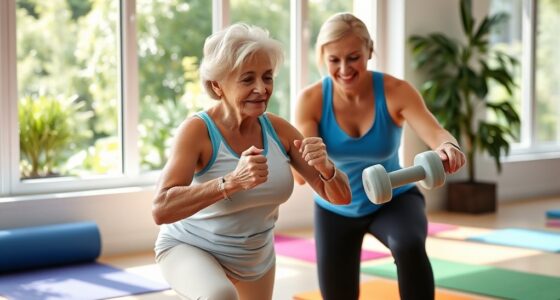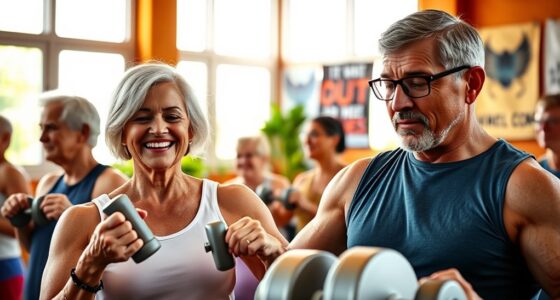The ultimate gym for you as a senior combines tailored fitness programs with community support and a strong focus on safety. Look for facilities offering low-impact classes, resistance training, and group activities, like Tai Chi and chair yoga, to enhance balance and flexibility. Accessible locations with non-slip flooring and flexible hours make it easier to stay fit. Join social activities to foster connections and boost your mental wellness. Explore how to maximize your fitness journey further!
Key Takeaways
- Offer senior-friendly classes like gentle pilates, chair yoga, and water aerobics tailored to promote physical fitness and social interaction.
- Ensure facilities are equipped with non-slip flooring, handrails, and adaptive equipment for enhanced safety during workouts.
- Provide flexible hours and accessible locations to accommodate diverse schedules and transportation needs for seniors.
- Incorporate community-led initiatives and networking opportunities to foster social connections and reduce isolation among participants.
- Implement fall prevention strategies through balance training and core strength exercises to enhance stability and reduce the risk of falls.
Availability and Accessibility of Fitness Centers for Seniors

When it comes to staying active, seniors often find themselves facing unique challenges in accessing fitness centers. Fortunately, programs like Silver Sneakers and EnhanceFitness provide tailored classes in countless locations, making it easier for you to engage in physical activity. Many YMCAs offer senior-friendly classes like gentle pilates and chair yoga, though availability varies. You can also explore community-led initiatives that bring fitness programs right to your neighborhood. Access to senior-friendly gym workout programs can significantly enhance your fitness journey and encourage regular participation. Additionally, understanding funding options for fitness programs can help seniors who may face financial barriers to participating in these activities. Engaging in physical activity can also boost your overall health by reducing the risk of chronic diseases.
Creating a supportive environment through networking opportunities can also motivate seniors to maintain an active lifestyle together. Look for gyms equipped with non-slip flooring, handrails, and adaptive equipment to guarantee your safety. With well-lit spaces and accessible facilities, you’ll find it easier to navigate and feel confident while exercising. Many fitness centers, like those at local business hours, offer flexible hours that cater to the diverse schedules of seniors, ensuring you can find time to work out. Additionally, participating in community fitness programs can foster social connections that enhance your overall well-being. Embracing these options can help you stay active and connected with others in your community.
Health Benefits of Regular Exercise for Older Adults

Regular exercise isn’t just about staying fit; it’s essential for your overall health and well-being as you age. Engaging in regular physical activity helps prevent heart disease and diabetes, while boosting your immune function to fend off infections. Regular physical activity can also reduce healthcare costs associated with chronic diseases, making it a smart investment in your health. Additionally, hydration and nutrition play vital roles in maintaining energy levels during exercise. Moreover, incorporating exercise into your routine can foster a growth mindset, leading to increased motivation and resilience. Practicing mindfulness can further enhance your exercise experience, helping you stay focused and present in your workouts. Engaging in creative activities like crochet can also provide protective styling benefits for your mental health and enhance your overall well-being.
It can lower the risk of certain cancers and chronic conditions like high blood pressure. Mentally, exercise releases endorphins, alleviating stress and anxiety, and improving your sleep quality. You’ll also enhance cognitive function, reducing the risk of dementia. Engaging in activities like yoga or Pilates can improve flexibility and strength, further benefiting your physical health.
Physically, maintaining strength and flexibility through exercise lowers your fall risk and supports mobility. Plus, being active fosters social connections, helping combat loneliness. Ultimately, a consistent routine can increase your longevity and quality of life, ensuring you stay independent and vibrant.
Types of Exercises Ideal for Seniors

Finding the right types of exercises is essential for seniors who want to maintain their health and energy. Low-impact options like chair yoga, cycling, and swimming offer great benefits without stressing your joints. These exercises enhance strength, flexibility, and cardiovascular health. Incorporating resistance training with bodyweight exercises or resistance bands can build muscle and improve functionality. Regular exercise can also reduce fall risk, which is crucial for maintaining safety among older adults. Additionally, engaging in physical activities can help reduce anxiety and depression symptoms in seniors. As for endurance, walking or water aerobics can boost your mood and circulation, while dance-based workouts like Zumba keep it fun. Comprehensive hearing evaluations can also be beneficial to ensure seniors are aware of their hearing health as they engage in physical activities. To further support emotional well-being, it’s important to consider the benefits of maintaining involvement in community activities or group exercises. Balance and flexibility are vital, so try tai chi, yoga, or simple exercises like heel-to-toe walking. Moreover, participating in regular exercise can lead to long-term energy savings, which positively impacts overall vitality and wellness among seniors. Engaging in physical activities not only improves fitness but can also help enhance mental resilience, which is crucial for navigating life’s challenges.
Fall Prevention Strategies Through Physical Activity

To keep yourself safe and active, incorporating physical activity into your routine is essential for fall prevention. Regular exercise strengthens your muscles, enhances balance, and improves flexibility, considerably reducing your fall risk. Engaging in exercises that improve core strength can further stabilize your body during movements and enhance overall balance. It’s crucial to remember that children’s welfare is of utmost importance during any significant life changes, including physical health challenges. Research shows that predictive modeling can help identify individuals at risk of falls, allowing for tailored interventions. Additionally, adopting an iterative process in your exercise routine can help you continuously improve your strength and balance over time. Incorporating essential skills for homesteading can also promote a more active lifestyle through gardening and outdoor activities.
Incorporating multi-functional products into your fitness routine, such as resistance bands that also enhance core strength, can provide added benefits. Focus on balance training activities, like standing on one leg or tandem walking, to challenge yourself. Aim for exercises at least three times a week for over 32 weeks to maximize benefits.
Community-based programs, such as Tai Chi and group classes, can reduce fall risk by up to 39%. You might also consider Pilates and yoga, which enhance balance and stability.
The Importance of Social Engagement in Fitness Programs

While physical activity is essential for maintaining health, the social connections formed in fitness programs are equally important for seniors. Engaging in group classes or team sports reduces social isolation, allowing you to build meaningful relationships. As you participate, you’ll notice improvements in mental health, reduced anxiety, and enhanced happiness. The supportive environment fosters motivation, encouraging you to continue exercising while boosting your self-esteem. Additionally, strong communication skills can help you create lasting friendships within these groups, further enriching your experience.
Moreover, establishing consistent daily routines in conjunction with exercise can lead to improved overall well-being, particularly in managing stress and anxiety levels. Furthermore, engaging in group fitness classes can enhance your social network, providing additional avenues for support and connection. Plus, social engagement contributes to better cognitive health and a greater sense of belonging. Regular exercise not only improves your fitness but also enriches your life. Whether it’s a yoga class, a walking group, or even virtual workouts, these activities create lasting bonds and promote overall well-being. Additionally, participating in physical activities can help maintain high vibrational energy which supports a more positive mindset and overall vitality. Furthermore, joining dog owner groups can also provide valuable social interaction and shared experiences, enhancing your fitness journey through active lifestyles.
Frequently Asked Questions
What Should Seniors Wear for Comfortable Exercise Sessions?
When you’re gearing up for comfortable exercise sessions, focus on activewear that prioritizes comfort and breathability.
Choose moisture-wicking fabrics to keep you cool and opt for adaptive clothing with features like magnetic closures for easy dressing.
Layer your outfits to adjust to temperature changes, and don’t forget supportive footwear with good arch support and slip-resistant soles.
This way, you’ll feel confident and ready to enjoy your workout while staying comfortable.
How Can Seniors Track Their Fitness Progress Effectively?
Imagine your fitness journey as a winding path through a vibrant forest. To navigate it effectively, you’ll want tools like fitness trackers, smartwatches, and mobile apps.
These devices act like guiding stars, illuminating your steps, heart rate, and activity levels. By maintaining digital logs, you can map your progress and celebrate milestones along the way.
Regular assessments, like the Senior Fitness Test, help you guarantee you’re on the right track to achieving your health goals.
Are There Specific Exercises for Seniors With Arthritis?
Yes, there are specific exercises you can do if you have arthritis.
Water aerobics and swimming are excellent for reducing joint stress, while cycling is low-impact and great for your heart.
Tai Chi and yoga enhance flexibility and balance.
Resistance training with light weights supports joint health, and chair exercises can be done if you have limited mobility.
Always listen to your body, and consult your doctor before starting any new routine.
How Often Should Seniors Exercise Each Week?
So, you think you can just lounge around and let the couch do the heavy lifting? Think again!
You should aim for at least 150 minutes of moderate-intensity aerobic activity each week. That’s about 30 minutes on five days—easy peasy!
If you’re feeling ambitious, 75 minutes of vigorous activity works too.
Mixing it up keeps things interesting, so get moving and enjoy the benefits of staying active and healthy!
What Should Seniors Do if They Experience Pain During Workouts?
If you experience pain during workouts, stop immediately and assess your discomfort.
Don’t push through it; your body’s signaling a need for a break. Consult with a healthcare provider if the pain persists.
Consider modifying your routine by incorporating low-impact exercises or using assistive devices.
Focus on gradual intensity increases, stay hydrated, and listen to your body.
It’s crucial to prioritize safety and adapt your workouts to guarantee ongoing participation without exacerbating pain.
Conclusion
To summarize, finding the right gym can truly transform your fitness journey as a senior. Regular exercise not only boosts your physical health, but it also enhances your mental well-being and social life. Plus, engaging in activities with others can make workouts more enjoyable. So, don’t just think about staying fit; embrace the community around you. After all, it’s often said that laughter is the best medicine—so why not share some laughs while you’re at it?









